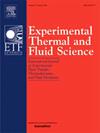On the interaction of vortical structures and shear layer in turbulent flow around trapezoidal prisms with varying aspect ratios
IF 3.3
2区 工程技术
Q2 ENGINEERING, MECHANICAL
Experimental Thermal and Fluid Science
Pub Date : 2025-07-20
DOI:10.1016/j.expthermflusci.2025.111570
引用次数: 0
Abstract
The spatiotemporal dynamics of turbulent flow induced by trapezoidal prisms in a uniform flow are studied using time-resolved particle image velocimetry (TR-PIV). Three prisms with aspect ratios (AR, defined as the ratio between lower surface length and height) of 1, 2, and 3 (denoted as AR1, AR2, and AR3, respectively) were tested at a Reynolds number of 10000 based on the incoming velocity and prism height. In the wake region of the prisms, two recirculation bubbles form. For the AR1 prism, the bubbles are almost symmetric in size, whereas for AR2 and AR3 prisms, the upper bubble is significantly larger than the lower one. The peak values of the Reynolds stresses in the wake region decrease with increasing AR. Quadrant analysis reveals that the strength of sweep and ejection events increases with decreasing aspect ratio, enhancing flow recovery within the recirculation zone. The vertical derivative of Reynolds shear stress plays a major role in the higher flow recovery for AR1, but as the aspect ratio increases to 3, the vertical derivative of tangential momentum becomes the dominant factor. The nondimensional fundamental shedding frequencies for the AR1 and AR2 prisms are 0.13 and 0.11, respectively, whereas dual shedding frequencies of 0.05 and 0.12 are observed for the AR3 prism. Frequency synchronization induced by von Kármán (VK) vortex shedding remains strong from the leading edge to the wake region in the cases of AR1 and AR2 while becoming limited to the wake region for AR3.
不同宽高比梯形棱柱周围湍流中旋涡结构与剪切层的相互作用
采用时间分辨粒子图像测速技术(TR-PIV)研究了均匀流动中梯形棱镜引起的湍流的时空动力学。根据入射速度和棱镜高度,在雷诺数为10000的条件下,测试了三个长宽比(AR,定义为下表面长度与高度之比)分别为1、2和3的棱镜(分别记为AR1、AR2和AR3)。在棱镜的尾迹区,形成两个再循环气泡。对于AR1棱镜,气泡的大小几乎是对称的,而对于AR2和AR3棱镜,上部气泡明显大于下部气泡。尾迹区的峰值雷诺数随增径比的增大而减小。象限分析表明,随着展弦比的减小,掠流和喷射事件的强度增大,增强了再循环区内的流动恢复。雷诺数剪应力的垂直导数对AR1的高采收率起主要作用,但当展弦比增加到3时,切向动量的垂直导数成为主导因素。AR1和AR2棱镜的无量纲基本脱落频率分别为0.13和0.11,而AR3棱镜的双脱落频率为0.05和0.12。在AR1和AR2中,由von Kármán (VK)涡脱落引起的频率同步从前缘到尾迹区域保持强烈,而在AR3中则局限于尾迹区域。
本文章由计算机程序翻译,如有差异,请以英文原文为准。
求助全文
约1分钟内获得全文
求助全文
来源期刊

Experimental Thermal and Fluid Science
工程技术-工程:机械
CiteScore
6.70
自引率
3.10%
发文量
159
审稿时长
34 days
期刊介绍:
Experimental Thermal and Fluid Science provides a forum for research emphasizing experimental work that enhances fundamental understanding of heat transfer, thermodynamics, and fluid mechanics. In addition to the principal areas of research, the journal covers research results in related fields, including combined heat and mass transfer, flows with phase transition, micro- and nano-scale systems, multiphase flow, combustion, radiative transfer, porous media, cryogenics, turbulence, and novel experimental techniques.
 求助内容:
求助内容: 应助结果提醒方式:
应助结果提醒方式:


